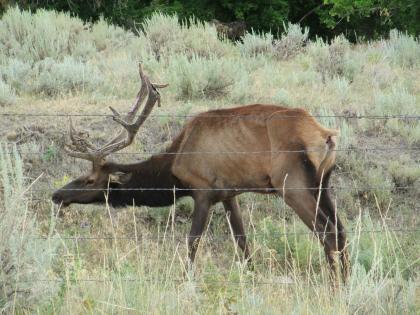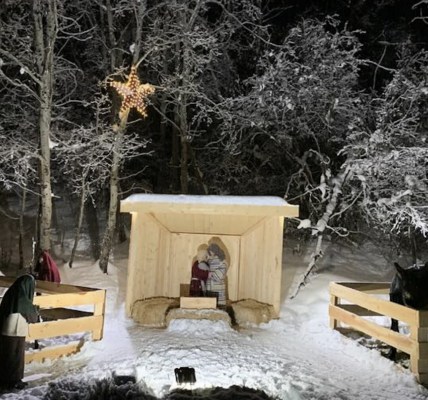
By Billy Arnold
Jackson Hole News&Guide
Via- Wyoming News Exchange
JACKSON – Soon after Michele Voorhees pulled the trigger, she realized something was up.
It was Sept. 16 and Voorhees, 58, was out hunting in Granite Creek with her niece when they saw a mule deer grazing just across the creek. She pulled the trigger and hit the buck in the lungs. But when the hunter looked up from her rifle, she realized she’d seen the deer’s ribs.
“Something’s going to be wrong,” Voorhees told her niece.
The deer later tested positive for chronic wasting disease, an always-fatal neurological condition that’s begun spreading in Jackson Hole’s wildlife. Though still relatively rare — prevalence in local elk and mule deer herds is estimated to be well below 1% — Wyoming Game and Fish Department officials anticipate that experiences like Voorhees’ will only become more common.
That means human handling of carcasses is becoming even more important.
At the same time, increased fees for hunters and agencies discarding the remains of dead animals may be encouraging risky behavior.
As fees have tripled, game wardens like Kyle Lash are responding to roughly twice as many illegally dumped carcasses on the landscape. Doing so increases the odds of spreading the resilient misfolded protein that causes CWD.
“Hunters are saying ‘I don’t want to pay money to dump bones in the landfill,’ ” Lash said.
Though Lash usually responds to 10 or 11 reports of illegally discarded carcasses annually, in 2022 he’s responded to about 20. There are also a few weeks of hunting season to go.
This December will mark one year since Teton County Integrated Solid Waste and Recycling closed its dead animal pit and changed its fee structure.
It now requires hunters to pay $433 a ton to dump carcasses. That translates to roughly 21 cents a pound, or just under $35 for 150 pounds of discarded bones, pelts and muscles.
The cost of transporting dead animals down to Sublette County is built into that calculation.
But that fee is more than three times Teton County’s rate for municipal solid waste: What hunters used to be charged when they dropped off their animals.
“Folks have told me point blank, ‘If I’d have known this was going to cost me $40 to take this thing to the dump like I was told to do, I would’ve never done it,’ ” said Ben Wise, Game and Fish’s regional disease biologist. “People don’t want to pay a big fee for doing the right thing.”
Wise said his employer and the Wyoming Department of Transportation also are bringing fewer carcasses to the Trash Transfer Station. Both state agencies used to pay nothing to drop off animals hit on the road, or picked up in a bout of carcass clean up. Now, they’re charged a fee.
“That’s all tied to the fact that it costs money,” Wise said of the decrease in carcass disposal. “When it was free, it was convenient. Now it’s an inconvenience and it’s got an extra cost.”
Prions, the misfolded proteins that cause CWD, are nearly impossible to destroy and can remain on plants and soil for years after being introduced. Infected deer that do something as innocuous as eat grass can spread the prions through saliva. If they die in the woods, the virulent compounds stored in their brain and spinal cord can seep into the surrounding ecosystem as their bodies decompose.
Other ungulates can then pick up the disease by nibbling grass or coming into contact with bodily fluids in the same area. The risk is higher when animals crowd together in close quarters, like they do on the National Elk Refuge.
Wildlife officials say transmission through natural processes like death and salivation — drooling, in other words — is somewhat inevitable, particularly as the disease spreads.
But they don’t want humans to make that problem worse.
Transporting and dumping infected carcasses in areas where the disease isn’t prevalent could spread the condition that zombifies deer, elk and moose faster than would happen otherwise.
Teton County Integrated Solid Waste and Recycling’s dead animal pit closed in December 2021, as part of a landfill closure mandated by the Wyoming Department of Environmental Quality to prevent groundwater contamination. When officials first talked about closing the pit, where hunters could discard carcasses for a smaller fee, the idea was to send animal refuse to Bonneville County, Idaho with the rest of the county’s trash.
But now that CWD is circulating in Teton County, Wyoming, Brenda Ashworth, the superintendent of Integrated Solid Waste and Recycling, said Idaho officials don’t want the potentially infected carcasses.
Instead, Yellow Iron Excavating and Waste Removal, which runs the county facility on a contract, has been collecting carcasses in a dumpster and hauling them by truck to a Sublette County dump. That has increased the cost of disposal, which the county is passing on to hunters.
Officials have spent years talking about how to handle dead animals. They’ve floated the idea of purchasing a community carcass incinerator capable of burning at high enough temperatures to wipe out the virulent prions, though they have decided the costs are prohibitive.
The National Elk Refuge did purchase an incinerator, but it’s not for public use — and likely won’t be. Refuge managers don’t want any kind of diseased animals entering the refuge, alive or dead. Transporting remains could spread the prions. Refuge Manager Frank Durbian said the wildlife sanctuary he oversees has little appetite for increasing the risk of disease transmission.
“We do not want more diseased animals coming onto the refuge,” Durbian said.
That leaves local officials with a less-than-ideal solution — but the only one available.
“I don’t think any manager is like, ‘Yeah, we’ve got a great solution,’ ” Ashworth said. “It’s not a great solution. I think we’re all a little nervous.”
Others are a bit disgusted.
Trudging through the snow as she walked her 3-year-old dog Enzo on Henry’s Road on Monday morning, Sylvia DiPrisco recounted the decaying ungulate parts that her enthusiastic goldendoodle had found on the east bank of the Snake River. Bones. Belts. And a gut pile Enzo found south of Swinging Bridge. That gut pile was a rare find, but DiPrisco was confident it came from a hunter. She could see marks in the sagebrush where the driver backed up over the side of the road and presumably “shoveled it out.” Enzo was unmistakably attracted to the pile.
“They love to roll in it,” DiPrisco said of dogs. “Ugh.”
On Monday, Enzo’s bone radar was tingling. Fifteen minutes down the road, he picked up a scent, ran ahead and dug through the snow, gleefully extracting a full spinal column.
DiPrisco picked it up and hucked it over the side of the road. She’s not so bothered by the carcasses. They’ve been showing up on Henry’s Road for years, and Lash, the south Jackson game warden, said that’s one of the most common illegal dump sites in the county. But she hopes local officials can find a solution that entices people to throw out their refuse responsibly.
“The answer would be a free, easily accessible place to dump your carcasses,” DiPrisco said.
Brains and spinal columns like the one DiPrisco’s dog found are the biggest concern, officials said. Since the disease is neurological, the central nervous system is most likely to carry the prions, though it can spread to other parts of ungulates’ bodies — including muscles — as the disease progresses. Game wardens find illegally discarded heads and spines most often.
Regulations prevent people from moving heads and spines around the state, though there’s an exception: If remains are “disposed of in any approved landfill or approved incinerator.”
If hunters won’t bring the head and spine to either of those locations, rules require them to leave that part of the skeleton in the field. Lash recommends doing so by quickly quartering the animal, which he said is much more efficient than packing out the whole animal.
Leaving the head and spine where the animal was shot is ok, Lash said, but transporting them to another location is not because if a hunted animal has CWD its prions are likely already in the soil and environment where it was killed.
“By having that animal already on the landscape, eating that blade of grass and drooling on it, it has already spread its prions to that area,” Lash said.
Wise said officials now need to make it “affordable and attainable to do the right thing.”
Ashworth is open to discussing subsidizing costs for partner agencies, like Game and Fish and WYDOT. As opposed to hunters, Ashworth said the agencies aren’t “carcass generators.” She also said the Teton County Board of County Commissioners could subsidize disposal.
But she said it would be a tall ask to raise costs in other parts of Teton County Integrated Solid Waste and Recycling to subsidize getting rid of hunters’ carcasses.
The waste center runs through an enterprise fund, meaning it has to cover its costs. Lowering costs in one area, like carcass disposal, would probably mean increasing costs elsewhere.
“I think it would be harder for the community to take on that cost for people who are generating carcasses,” Ashworth said, referring to the hunters.
Money could probably be found for subsidies, Wise and Ashworth said. But the superintendent of the county’s waste removal program said it likely wouldn’t come from the private sector. If a nonprofit said it was willing to pay to haul the carcasses away, Ashworth would be open to that.
“But currently, we just don’t have any outlet,” she said.
When Voorhees shot her buck, she chose to remove it from the field.
After she hit it, it moved about 30 yards and died in a campground just across the way. Voorhees and her niece were able to pull up, pack the deer into the truck, and drive it home.
But it was so emaciated, Voorhees’ hopes of filling the freezer were dashed.
“It was so skinny that it was an in and out shot,” she said. “It did not stop the bullet.”
The hunter called Lash, who came to her house and extracted its lymph nodes. A few days later, the test came back positive.
But Voorhees had already disposed of the deer because it looked so unhealthy. For one, its antlers still had velvet, the soft furry skin that covers them until the late summer and early fall, when deer rub it off. If they don’t, it’s usually a sign of stress, Lash said.
Plus, the animal was so skinny that Voorhees guessed she would have only gotten 10 or 15 pounds of meat off its skeleton.
She brought it to the transfer station. That cost roughly $20, she said.
Last January, when the new fee structure was in place, she brought the remains of a more meaty elk that she’d hunted and paid about $30.
Despite the disappointment of a hunt gone wrong, Voorhees was fine with paying the $20 this year.
“That’s just the cost of doing business,” she said. “Do it right. It’s not that expensive.”




